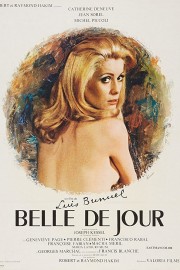Belle de Jour
I feel as though Luis Bunuel’s erotic drama, “Belle de Jour,” would likely find an audience within the fans of the “Fifty Shades” trilogy if it weren’t for the fact that it’s a foreign film. That sounds condescending, I know, but the sad truth is that a lot of audiences don’t have interest in foreign cinema, especially that which was made 50 years ago, and that is a shame. But I make the correlation between Bunuel’s sly film and E.L. James’s “mommy porn” trilogy with a genuine belief that if you like the latter, I think you’ll find something intriguing about the former. This is not to equate them in quality (Bunuel’s film is miles ahead of the “Fifty Shades” movies in that regard), but in terms of the place they come from, I feel like there’s something connective between them.
Like with many foreign directors, I am shamefully behind on my viewing of Bunuel’s career. This is only the second film of his I’ve reviewed other than his surreal short film, “Un Chien Andalou,” and I think the only other film of his I’ve seen is “That Obscure Object of Desire,” so I have some catching up to do. But that such small of a sampling has me hooked in to see more is no small feat for a filmmaker who works in surreal, sometimes darkly comedic, modes, although the appreciation for David Lynch I’ve acquired over the years helps me with that. Lynch learned some of his tricks from Bunuel, so it’s difficult not to imagine liking his work. That being said, I do feel like, with “Belle de Jour,” the emotional pull of the story only goes so far for me, although I am fully engaged in Severine’s story from beginning to end.
Bunuel’s film is based on a novel by Joseph Kessel, but it’s so identified as a Bunuel film it would not surprise me if many Bunuel fans even remembered that. The film tells the story of Severine (Catherine Deneuve), a stunningly beautiful, 23-year-old wife of a doctor named Pierre (Jean Sorel). The first time we meet them, they are taking a carriage ride in a park, having a discussion. Pierre asks the drivers to stop the carriage, and they force Severine out. He is upset with his wife, and the drivers drag her to an area, tie her to a tree, and whip her like they would the horses. We then see them in their apartment, and she has just woken up. What we have seen is one of her dreams, and we find out soon that the couple is coming up on their 1-year wedding anniversary, and get the idea that they have not had sex yet. They go on a holiday for their anniversary where we meet a friend of theirs (Henri, played by Michel Piccoli) and his wife, and Henri is clued in to Severine’s mind when it comes to sex- that, despite her beauty and pure nature with her husband, she has secret desires. One day, when she rebuffs some natural flirting with him, he tells her of “houses” where housewives such as herself go during the day to make money for themselves, and satisfy their secret desires away from their husbands. Severine is both offended and intrigued, so she goes to one of these houses, awakening a side of her she hasn’t been ready to share with her husband yet.
In that brief plot description, I think you’ll be able to see why I thought of this maybe finding an audience with the “Fifty Shades” crowd. This is about a woman who fulfills secret desires through sexual exploits that would be seen, by many, as taboo, but one of the things that elevates it beyond a mid-’90s skinimax movie starring Shannon Tweed is Bunuel’s ability to put us firmly in Severine’s mindset and perspective. This is her story, and we see the conflict and tension in her at the beginning and then, when she begins working at the house, and becomes quite popular with its clientele, we see her begin to open herself up more, emotionally-speaking, to her husband, even if she can’t quite meet his desires physically. On this viewing, I also wondered in Bunuel had the film noir horror classic, “Cat People,” in mind, as it touches on similar thematic material, and, as a way of distinguishing Severine’s fantasies with her reality, he uses cat meows and references to cats in the fantasy scenes. Like that film, “Belle de Jour” engages us completely in the psychological dilemma of its heroine, and it involves an inability to physically consummate her marriage. But Bunuel has his own ideas at work, as he puts Severine between a rock and a hard place when she takes on a grotesque gangster (Marcel, played by Pierre Clémenti) because of the erotic charge his disgusting appearance gives her. The problem is, Marcel feels something more for her, and an unexpected visitor makes her rethink what she is doing, leading to an ending of cruel irony for all involved.
Bunuel’s film is sensual and entertaining, and not really rife with nudity or actual sex. That is left to the imagination, which is really what the film is about. This takes us into Severine’s inner thoughts, her erotic mind, and the direction that leads her life when she finds an outlet for those desires. It’s a rich landscape, although I wonder if the film shouldn’t have been more darkly comedic than dramatic. There’s some humor in the film, to be sure, but I feel like it’s muted, and that doesn’t benefit the film, in the end. What does is Bunuel’s command of film language to get us into Severine’s head, and Deneuve herself as Severine. This was an early performance by her and she lands every note of Severine’s journey effortlessly as she follows Bunuel down this surreal rabbit hole of erotic desire.










